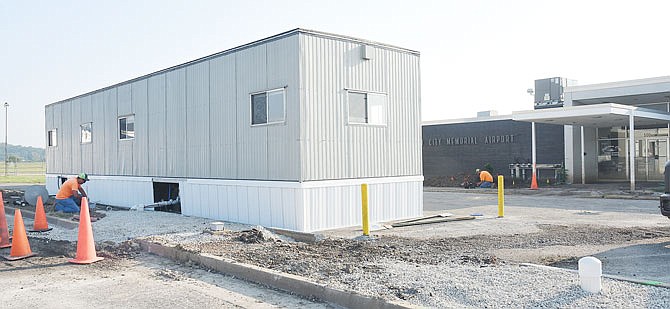One of the first steps in the process of demolishing the damaged terminal at Jefferson City Memorial Airport began Thursday with an inspection.
Before demolition can take place, the building has to be inspected for asbestos, among other things, to determine what needs to be done during demolition, said Britt Smith, Jefferson City Public Works operations director.
Inspecting the building will guide demolition as far as disposal of materials and other safety measures.
It's the first step in the process of demolition for the terminal at the airport, which was heavily damaged by flooding this spring. In August, public works staff recommended the building be demolished.
If the terminal wasn't demolished, it would need to be raised about 9 feet to comply with the Federal Emergency Management Agency's structural improvement rule, Jefferson City Engineer David Bange previously told the News Tribune. Structures in a floodplain also can't make improvements that exceed 50 percent of the structure's value.
The airport itself reopened in July after the flooding receded, but the terminal has been closed since May.
Once the asbestos inspection is completed, a bidding process will begin for the demolition, Smith said.
He hopes to have the bid advertised for the demolition within the next 45-60 days. After that, the bidding process will take approximately another 60 days from advertisement to award of the contract by the Jefferson City Council.
Demolition would take place soon after. Theoretically, the timeline for demolition to begin is about five to six months.
As far as building a new terminal, the timeline is much more up in the air, Smith said. Right now, they're in a contract with consultant Jviation to complete a feasibility study on a possible design for a new terminal. But there are certain things holding the process back.
"No. 1 - we still haven't repaired the levees across the river yet. We wouldn't want to do any work until that levee repair is done," he said.
The Capital View Levee, across the river from downtown Jefferson City on the left descending bank, was breached by floodwaters May 24, causing the flooding at the airport and throughout North Jefferson City. The largest of the five or six large breaches was about 1,000 feet long.
In August, the U.S. Army Corps of Engineers announced the Jefferson City area levee districts had been approved for rehabilitation assistance, but no timeline has been stated for when repairs will take place. Smith hopes repairs will happen early 2020.
The project also needs funding, he said, which is a big factor in when construction could take place.
"If you could tell me where the money is coming from, I could tell you how fast it would start," Smith said.
The airport is in North Jefferson City, which is part of Callaway County. Callaway County was one of many counties in Missouri declared part of the FEMA disaster area and can receive public and individual assistance from the federal government.
Bange said inspectors from FEMA were at the airport last week to inspect the terminal to begin the process of receiving aid from the agency.
The asbestos inspection and demolition will be paid for with funds from the insurance on the terminal building. The feasibility study for the new terminal is being funded 90 percent through a grant, with the other 10 percent coming from the city.
Other repairs at the airport will take place sooner. Engineers will soon make repairs to field lights like those on the runway. A temporary trailer has been placed at the airport to provide an office for airport Manager Ron Craft.
Smith said the city applied for an emergency work grant through the Missouri Department of Transportation to repair the taxiway lighting.
Other work at the airport recently began as well. A building permit was issued in early October for flood repairs at the Missouri Department of Conservation's hangar, which had minor damage.

